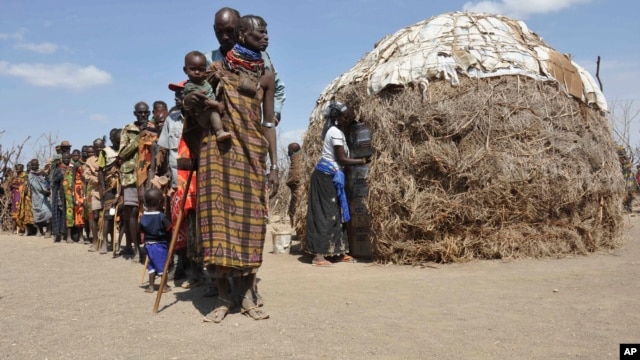Turkana people wait in a line to receive food from Oxfam in central Turkana district, Kenya in August 2011. The U.N. says tens of thousands of people died in Somalia, Kenya, Ethiopia and Djibouti from famine. Five years later, drought has returned.
11/26/2015
Worries of Famine After Drought in Ethiopia
- Playlist
- Download (right-click or option-click and save)
Drought and famine killed more than 400,000 people inEthiopia in the early 1980s. The country’s governmentis seeking aid to make sure that doesn’t happen again.
In a country where 85 percent of the people arefarmers, millions are in need of aid.
Ethiopia needs $250-million in assistance so that 8million people do not go hungry.
One million metric tons of wheat for the next fourmonths will cost almost $300 million.
Getachew Redda is a government spokesman. Hesays the Ethiopian government will be able to managethe drought with the financial aid. But Ethiopia musthelp farmers by developing more wells and irrigationprojects so they are not so dependent on rain.
Weather experts say the drought is caused by El Niño, an extreme weather pattern. According to the NationalOceanic and Atmospheric Administration in the UnitedStates, El Niño results in warmer-than-normal water in the Pacific Ocean that affects climates to the East.
Historically, droughts should be expected every 10 to 12 years. But as climate changes, rain will be lessreliable and less predictable.
Government officials say projects that create long-termsolutions are more important than temporary wheatdistribution.
Wagayehu Bekele is the director of the agriculturaltransformation agency in Ethiopia. He says farmersmust adapt their schedules and work when the weatheris good, instead of during traditional planting seasons.
“Traditional wisdom is not working anymore. If the rainstarts early, they don’t start sowing or planting.”
Agriculture makes up about half of Ethiopia’s economy. The lack of rain is also affecting the health of livestock.
Technology plays an important role in making the country more modern and its agriculture industry more sustainable, says one environment advocate.
Araya Asfaw is the director of the Horn of Africa Regional Environment Centerand Network. He says more investment is needed in weather tracking andprediction.
“We need to have more meteorological stations all over the place.”
The crisis is building. Right now 8 million people are in danger of going hungry. But if the aid does not arrive soon, the United Nations estimates that numbercould soon double.
I’m Dan Friedell.
Marthe van Der Wolf wrote this story for VOA News. Dan Friedell adapted it for Learning English. Kathleen Struck was the editor.
What do you think about the drought and famine in Ethiopia? We want to hearfrom you. Write to us in the Comments section or on our Facebook page.
[Editor's note: A previous version of this story incorrectly said that Ethiopia'spopulation was nearly wiped out by famine in the early 1980s. Although morethan 400,000 people died in the famine, the national census reported that thecountry's total population in 1984 was about 42,000,000.]







No comments:
Post a Comment